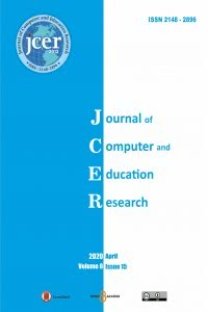Using Arduino in Physics Teaching: Arduino-based Physics Experiment to Study Temperature Dependence of Electrical Resistance
Physics education, Arduino platform, Arduino experiment, electrical resistance
Using Arduino in Physics Teaching: Arduino-based Physics Experiment to Study Temperature Dependence of Electrical Resistance
Phiysics education Arduino platform, Arduino experiment, electrical resistance, temperature coefficient,
___
- Arduino temperature control library. Available at: https://github.com/milesburton/Arduino-Temperature-Control-Library (accessed 11 May 2019).
- Atkin, K. (2016). Using the arduino with makerplot software for the display of resonance curves characterisic of a series LCR circuit. Physics Education, 51(6), 065006.
- Bezerra, A. Z. L. N., Cabreira, F. M., Freitas, W. P. S., Cena, C. R., Alves, D. C. B., Reis, D. D., & Goncalves, A. M. B. (2019). Using an arduino to demonstrate faraday’s law. Physics Education, 54(4), 043011.
- Chen, S., Lo, H C., Lin, J.W., Liang, J.C., Chang, H.Y., Hwang, F.K.& Wang, C.Y. (2012). Development and implications of technology in reform-based physics laboratories. Physical Review Special Topics-Physics Education Research, 8(2), 020113.
- Darrah, M., Humbert, R., Finstein, J., Simon, M.& Hopkins, J. (2014). Are virtual labs as effective as hands-on labs for undergraduate physics? A comparative study at two major universities. Journal of Science Education and Technology, 23(6), 803-814.
- DS18B20 waterproof temperature sensor datasheet. Programmable Resolution 1-Wire Digital Thermometer. Available at: https://datasheetspdf.com (accessed 10 May 2019). Eargle, J. (Ed.). (2012). Electroacoustical reference data. Springer Science & Business Media.
- Giancoli, D. (2009). 25. Electric currents and resistance ın jocelyn phillips physics for scientists and engineers with modern physics (4th ed.). Upper Saddle River, New Jersey: Prentice Hall.
- Gingl, Z., Mellar, J., Szepe, T., Makan, G., Mingesz, R., Vadai, G., & Kopasz, K. (2019). Universal Arduino-based experimenting system to support teaching of natural sciences. arXiv preprint arXiv:1901.03810.
- Hahn, M. D., de Oliveira Cruz, F. A., & Carvalho, P. S. (2019). Determining the speed of sound as a function of temperature using arduino. The Physics Teacher, 57(2), 114-115.
- Hsu, C.C.& Wang, T.I. (2018). Applying game mechanics and student-generated questions to an online puzzle-based game learning system to promote algorithmic thinking skills. Computers & Education, 121, 73-88.
- Jaipal-Jamani, K.& Angeli, C. (2018). Developing teacher self-efficacy to teach science and computational thinking with educational robotics: using scaffolded programming scripts. In Self-Efficacy in Instructional Technology Contexts (pp. 183-203). Springer, Cham.
- Makan, G., Mingesz, R., & Gingl, Z. (2019). How accurate is an arduino ohmmeter?. Physics Education, 54(3), 033001.
- Meaden, G.T. (2013). Electrical resistance of metals. Springer.
- MoNEa. (2018). Fen bilimleri dersi (ilkokullar ve ortaokul 3, 4, 5, 6, 7 ve 8. sınıflar) öğretim program [Science courses curriculum (primary and secondary school 3, 4, 5, 6, 7 and 8 grades)]. Ankara: Talim ve Terbiye Kurulu Başkanlığı.
- MoNEb. (2018). Ortaöğretim fen lisesi fizik dersi öğretim programı [Secondary science high school physics course curriculum]. Ankara: Milli Eğitim Bakanlığı Yayınları.
- OneWire Arduino Library, connecting 1-wire devices-PJRC. Available at: http://www.pjrc.com/teensy/arduino_libraries/OneWire.zip (accessed 11 May 2019).
- Pereira, N.S.A. (2016). Measuring the RC time constant with arduino. Physics Education, 51(6), 065007.
- Poker, D.B. & Klabunde, C.E. (1982). Temperature dependence of electrical resistivity of vanadium, platinum, and copper. Physical Review B, 26(12), 7012.
- Russell, D.W., Lucas, K.B.& McRobbie, C.J. (2004). Role of the microcomputer‐based laboratory display in supporting the construction of new understandings in thermal physics. Journal of Research in Science Teaching: The Official Journal of the National Association for Research in Science Teaching, 41(2), 165-185.
- URL-1. Arduino website. Available at: https://www.arduino.cc/ (accessed 11 May 2019).
- Sari, U. (2019). Using the Arduino for the experimental determination of a friction coefficient by movement on an inclined plane. Physics Education, 54(3), 035010.
- Sari, U., Pektaş, H.M., Çelik, H. & Kirindi, T. (2019). The effects of virtual and computer based real laboratory applications on the attitude, motivation and graphic ınterpretation skills of university students. International Journal of Innovation in Science and Mathematics Education (formerly CAL-laborate International), 27(1).
- Serway, R.A., Faughn, J.S. & Vuille, C. (2014). College physics brooks Cole Pub Co., Boston p 606.
- Tunyagi, A., Kandrai, K., Fülop, Z., Kapusi, Z., & Simon, A. (2018). Friction coefficient determination by electrical resistance measurements Physics Education, 53(3), 1-9.
- Yolkin, B. (2002). Lab Report–An Example. PHYS 340: Modern Physics Lab, 34. Available at: http://www.physics.purdue.edu/~fqwang/teaching/Phys340-Manual.pdf (accessed 11 May 2019).
- Young, H.D., Freedman, R.A., Sandin, T.R. &Ford, A.L., (1996). University physics 2 Reading MA: Addison-Wesley.
- Yayın Aralığı: 2
- Başlangıç: 2013
- Yayıncı: Tamer KUTLUCA
Game, Environment and Peer Effect on Children on the Digital Gaming Habits in Game Arcades
Alper ASLAN, Yiğit Emrah TURGUT, Türkan KARAKUŞ YILMAZ
Akademik Hayatta Sabır Üzerine Nitel Bir Çalışma
Hatice YILDIZ DURAK, Mustafa SARITEPECİ
Fen Bilgisi Öğretmen Adaylarının Mesleki Benlik Saygıları İle Yaşam Doyumlarının İncelenmesi
Motivation Scale for STEM Fields
Esra KIZILAY, Havva YAMAK, Nusret KAVAK
Hülya DEMİRCİOĞLU, Rabia ÖZDEMİR
Gülsüm Gülşah BURSALI, Burçin GÖKKURT-ÖZDEMİR
Improving Mathematical Reasoning and Mathematics Attitude of Disadvantaged Children in Rural Regions
Emrullah ERDEM, Tahsin FIRAT, Ramazan GÜRBÜZ
Öğretmenler Etik Davranıyor mu? Öğretmenlerin Meslektaşları Hakkındaki Algılarının İncelenmesi
